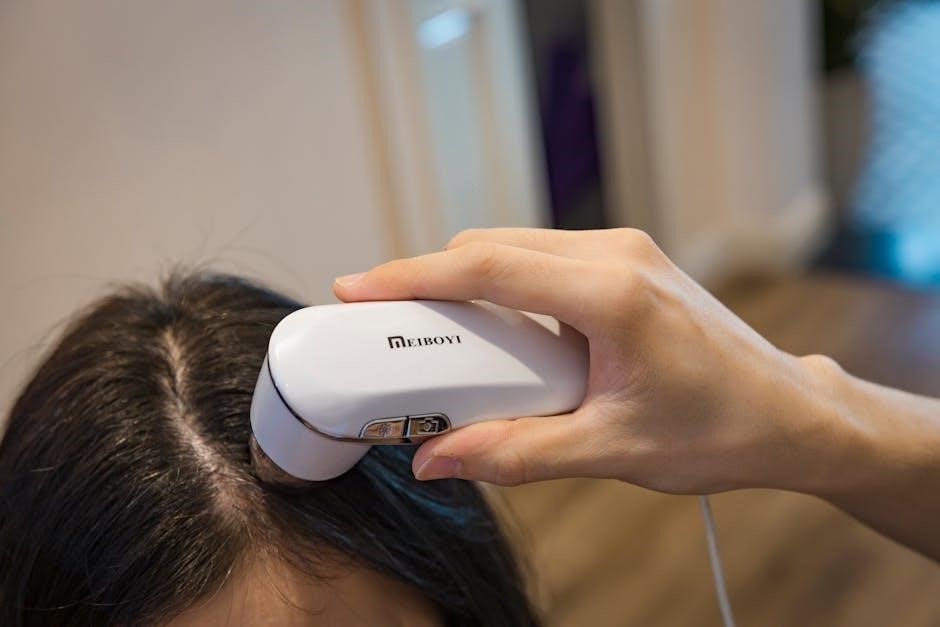
A head-to-toe assessment is a systematic method of evaluating a patient’s health status by examining body systems from the head to the toes. It ensures comprehensive data collection, aiding in accurate diagnoses and personalized care plans. This approach is essential for nurses to identify normal and abnormal findings, promoting early detection of health issues and improving patient outcomes. Regular use of this assessment technique enhances clinical skills and ensures holistic patient care.
Definition and Purpose
A head-to-toe assessment is a comprehensive, systematic evaluation of a patient’s physical condition, involving inspection, palpation, percussion, and auscultation. Its purpose is to gather objective data about the patient’s health status, identify potential or existing health issues, and guide individualized care planning. This method ensures a thorough and organized approach to patient evaluation, promoting early detection of abnormalities and improving overall outcomes. It is a fundamental skill in nursing practice, enhancing patient care quality and safety.
Importance in Nursing Practice
A head-to-toe assessment is vital in nursing practice as it ensures a thorough evaluation of a patient’s health status, promoting early detection of abnormalities. It enables nurses to gather accurate data, identify health trends, and develop targeted care plans. This systematic approach enhances clinical decision-making, improves patient outcomes, and reduces complications. Regular use of this assessment skill fosters a holistic understanding of patient needs, making it a cornerstone of effective nursing care and professional development.

Preparation for the Assessment
A thorough preparation is essential for a head-to-toe assessment. Review assessment guides, understand the process, and gather necessary tools to ensure a systematic and efficient evaluation of the patient.
Patient Preparation
Patient preparation is crucial for a successful head-to-toe assessment. Ensure the patient is comfortable, well-rested, and informed about the process. They should wear appropriate clothing for easy access to all body systems. Remove jewelry or accessories that may interfere with the examination. Encourage the patient to ask questions and express concerns beforehand. Proper preparation ensures accuracy and reduces anxiety, fostering a smooth and effective assessment experience.
Equipment Needed
The essential equipment for a head-to-toe assessment includes a stethoscope, blood pressure cuff, thermometer, penlight, watch with timer, measuring tape, and gloves. Additional tools may involve a clipboard for documentation, reflex hammer, and otoscope for detailed examinations. Ensure all equipment is clean, functional, and within reach to maintain efficiency and patient safety during the assessment process. Proper equipment preparation is vital for accurate and thorough evaluation of the patient’s health status.
Head Assessment
Head assessment involves examining cranial structures, checking for swelling, and using a penlight for inspection. It ensures thorough evaluation of the patient’s neurological and anatomical features.
Inspection and Palpation Techniques
Inspection involves visually examining the head for signs of injury, swelling, or asymmetry. Palpation uses gloved hands to gently assess the skull for tenderness or abnormalities. Nurses should systematically inspect facial symmetry, hair distribution, and scalp condition. Palpation helps detect fractures, lumps, or areas of pain. These techniques ensure a thorough evaluation of the head, aiding in early detection of potential health issues. Proper technique ensures patient comfort and accurate findings.
Checking for Signs of Injury or Illness
During the head assessment, nurses examine for signs of injury, illness, or abnormalities. Visual inspection identifies swelling, discoloration, or lacerations. Palpation detects tenderness, masses, or irregularities. The face is checked for symmetry, and the scalp is assessed for lesions or bleeding. Eyes and ears are evaluated for redness, discharge, or trauma. These observations help identify potential issues, ensuring timely intervention and preventing complications. Accurate documentation is crucial for continuity of care.

Eyes, Ears, Nose, and Throat (EENT) Assessment
The EENT assessment evaluates the sensory organs for abnormalities. It includes inspecting the eyes for acuity, ears for hearing, nose for congestion, and throat for inflammation or discharge. Techniques like otoscopy and visual acuity tests are used to ensure proper function and detect potential issues early, aiding in accurate diagnoses and treatment plans. Regular EENT checks are vital for maintaining sensory health and overall well-being.
Visual Acuity and Pupillary Response
Visual acuity is assessed using tools like the Snellen chart to measure sharpness and clarity of vision. Pupillary response involves evaluating reactions to light, including constriction and dilation. Abnormal responses, such as unequal pupils or sluggish reactions, may indicate neurological issues. Nurses use a penlight to test these reflexes, ensuring proper cranial nerve function. Accurate documentation of findings aids in diagnosing conditions like optic nerve damage or brain injuries, promoting timely interventions and improved patient outcomes.
Otoscopy and Rinne/Weber Tests
Otoscopy involves using an otoscope to examine the ear canal and eardrum, checking for abnormalities like redness or fluid. The Rinne and Weber tests assess hearing loss type using tuning forks. In Rinne, compare bone and air conduction; in Weber, lateralization helps differentiate conductive vs. sensorineural issues. These tests aid in identifying hearing impairments and guiding further diagnostic steps, ensuring accurate assessment of auditory function in head-to-toe evaluations.

Neck and Thyroid Assessment
The neck and thyroid assessment involves inspecting for swelling or deformities and palpating lymph nodes and the thyroid gland. It helps detect abnormalities, such as nodules or enlargement, that may indicate health issues, ensuring early identification of potential problems.
Range of Motion and Lymph Node Palpation
Assessing the neck’s range of motion involves evaluating flexion, extension, rotation, and lateral bending. Lymph node palpation checks for swelling, tenderness, or enlargement in cervical, submandibular, and supraclavicular nodes. This helps identify potential infections, inflammations, or malignancies. Nurses should use light pressure and systematic technique to ensure thorough examination without causing discomfort. Documentation of findings aids in tracking changes and guiding further diagnostic steps or interventions.
Thyroid Gland Examination
The thyroid gland examination involves inspecting for enlargement or asymmetry and palpating for nodules, tenderness, or irregularities. Nurses should have the patient swallow to better palpate the gland. The exam assesses for hyperthyroidism or hypothyroidism signs and thyroiditis symptoms. Documentation includes size, consistency, and any abnormalities. A thorough thyroid assessment is crucial for early detection of disorders, ensuring timely intervention and improved patient outcomes.

Respiratory Assessment
Respiratory assessment involves inspecting chest expansion, auscultating breath sounds, and percussing lung fields. It evaluates respiratory rate, rhythm, and depth, detecting signs of distress or abnormalities.
Inspection of the Chest
Inspection of the chest involves observing the patient’s breathing pattern, noting any signs of distress or asymmetry. Look for chest expansion, deformities, or scars. Ensure the patient sits upright and removes clothing to expose the chest. Observe for abnormal movements, such as accessory muscle use or paradoxical breathing. Document any visible abnormalities, like lesions or masses, to guide further assessment techniques.
Auscultation and Percussion of the Lungs
Auscultation involves listening to breath sounds using a stethoscope to assess airflow and detect abnormalities like wheezes or crackles. Percussion involves tapping the chest to evaluate lung density and detect issues such as fluid or air. These techniques help identify respiratory conditions, ensuring accurate diagnoses and guiding further interventions. Proper positioning and technique are crucial for obtaining reliable findings during the assessment.

Cardiovascular Assessment
Cardiovascular assessment evaluates heart rate, rhythm, and jugular venous distension to identify potential cardiac issues. Blood pressure measurement and peripheral pulse palpation are also crucial for comprehensive evaluation.
Heart Rate and Rhythm
Assess heart rate by palpating radial or carotid pulses, noting rate and rhythm. Normal adult heart rate is 60-100 beats per minute. Use a stethoscope to auscultate apical pulses for irregular rhythms. Document findings, noting sinus rhythm or irregularities like tachycardia, bradycardia, or arrhythmias. These findings help identify potential cardiovascular conditions, guiding further evaluation and care. Accurate assessment ensures timely detection of abnormalities.
Jugular Venous Distension and Blood Pressure
Assess jugular venous distension by positioning the patient at a 45-degree angle and observing the jugular vein. Measure blood pressure using a properly sized cuff, ensuring accuracy. Document systolic and diastolic readings, noting any elevations or abnormalities. JVD is measured in centimeters of water, with normal ranges typically below 3 cm. Elevated JVD may indicate heart failure or fluid overload, while blood pressure readings help detect hypertension or hypotension, guiding further evaluation and care. Ensure patient comfort and appropriate positioning for accurate findings, considering factors like anxiety or recent activity. Use reliable techniques and equipment, and correlate findings with other cardiovascular assessments for a comprehensive evaluation. Document details thoroughly, noting any abnormalities for timely intervention. Understanding these assessments is crucial for evaluating cardiovascular health within the broader head-to-toe assessment. Maintain a systematic approach and consider patient-specific factors, such as age, for accurate and reliable results.

Abdominal Assessment
Abdominal assessment involves evaluating the abdomen through inspection, auscultation, percussion, and palpation to identify abnormalities, such as tenderness, distension, or masses, ensuring comprehensive patient care.
Inspection and Auscultation
Inspection involves visually examining the abdomen for distension, scars, or discoloration. Auscultation uses a stethoscope to listen to bowel sounds, assessing for normal rumbling or abnormal silence. Ensure a quiet environment to accurately detect sounds. Document findings, noting the presence, absence, or irregularity of sounds. This step helps identify potential issues like ileus or obstruction, guiding further assessment and interventions. Proper technique ensures accurate data collection for patient care.
Palpation and Percussion Techniques
Palpation involves using the hands to assess tenderness, masses, or guarding. Light and deep palpation techniques help identify abdominal issues like pain or organ enlargement. Percussion provides information about underlying structures, detecting dullness, flatness, or resonance. These methods require skill to avoid causing discomfort. Documenting findings aids in diagnosing conditions such as ascites or organ enlargement, ensuring thorough patient evaluation and appropriate care planning. Proper technique is crucial for accurate assessment.
Musculoskeletal Assessment
Musculoskeletal assessment evaluates muscle, joint, and bone function. Techniques include range of motion testing and strength evaluation. Inspection for deformities or swelling aids in identifying abnormalities.
Range of Motion and Strength Testing
Range of motion testing evaluates joint mobility, while strength testing assesses muscle power. Nurses use goniometers to measure joint movement and manual muscle testing to grade strength. These techniques help identify limitations, weakness, or imbalance. Documenting findings aids in monitoring progress and tailoring care plans. Regular assessment ensures early detection of musculoskeletal issues, promoting effective rehabilitation and functional recovery for patients.
Inspection for Deformities or Swelling
Inspection for deformities or swelling involves visually examining the body for abnormalities. Nurses look for asymmetry, swelling, redness, or unusual posturing. Palpation may be used to detect tenderness or fluid retention. Identifying deformities helps in diagnosing fractures, joint dislocations, or conditions like arthritis. Swelling can indicate inflammation, injury, or circulatory issues. Accurate documentation of findings aids in monitoring progression and planning appropriate interventions to address underlying causes effectively.
Neurological Assessment
A neurological assessment evaluates the nervous system, focusing on brain and spinal cord function. It assesses consciousness, motor strength, sensory response, and reflexes to identify abnormalities.
Level of Consciousness and Cranial Nerves
The neurological assessment begins with evaluating the patient’s level of consciousness, including alertness, orientation, and responsiveness. Cranial nerve testing involves examining the 12 pairs of nerves originating from the brain. Common tests include assessing smell (CN I), hearing (CN VIII), and gag reflex (CN IX and CN X). Abnormal findings may indicate neurological deficits or conditions requiring further investigation. This step is crucial for identifying potential issues early in the assessment process.
Motor and Sensory Function
Motor function assessment involves evaluating muscle strength, tone, and coordination through active and passive movements. Reflexes are tested using a reflex hammer. Sensory function includes testing pain, touch, temperature, and vibration perception using tools like a soft object or tuning fork. Abnormalities may indicate neurological or peripheral nerve issues. This evaluation helps identify deficits in motor control or sensory processing, aiding in early detection of conditions requiring medical intervention. Accurate documentation is essential for tracking changes over time.
Skin Assessment
Skin assessment involves inspecting for lesions, rashes, or changes in color, texture, or integrity. Palpation evaluates temperature, turgor, and tenderness. Findings guide care plans and detect conditions early.
Inspection for Lesions or Rashes
During skin assessment, inspect for lesions, rashes, or unusual marks. Note color, size, shape, and distribution. Check for variations in texture or elevation. Look for symmetry and patterns. Assess for erythema, edema, or crusting. Identify areas of pigmentation changes or unusual pigmentation. Document findings meticulously, as lesions or rashes may indicate infection, allergies, or underlying conditions. A systematic approach ensures no areas are overlooked, aiding in early detection and accurate diagnosis.
Palpation for Temperature and Turgor
Palpation involves assessing skin temperature and turgor to evaluate hydration and overall health. Use the back of your hand to detect warmth or coolness. Gently pinch the skin to check elasticity; decreased turgor indicates dehydration. Note moisture levels and texture. Abnormal findings, such as excessive dryness or warmth, may suggest underlying conditions. Document observations accurately to guide further assessment and interventions, ensuring comprehensive patient care and monitoring.

Documentation of Findings
Accurate and thorough documentation of assessment findings is crucial for continuity of care; Record all observations, measurements, and patient-reported symptoms. Use clear, concise language and standardized formats to ensure consistency and readability. Include both objective data, such as vital signs, and subjective information, like patient concerns. Timely and precise documentation supports effective communication among healthcare providers and informs individualized care plans.
Recording Objective Data
Objective data in a head-to-toe assessment includes measurable and observable information, such as vital signs, physical examination findings, and diagnostic test results. These observations are recorded using clear, concise language to ensure accuracy and reliability. Examples include documenting heart rate, blood pressure, respiratory rate, and abnormalities detected during inspection, palpation, percussion, or auscultation. Accurate and precise recording of objective data is essential for tracking changes, informing diagnoses, and guiding patient care. Use standardized tools and formats to maintain consistency.
Subjective and Objective Findings
In a head-to-toe assessment, subjective findings are patient-reported symptoms, such as pain, fatigue, or dizziness. Objective findings are measurable observations, like elevated blood pressure or abnormal heart sounds. Together, these provide a comprehensive understanding of the patient’s health status. Accurate documentation of both types of data ensures a thorough evaluation, aiding in diagnosis and treatment planning. This integrated approach promotes holistic patient care and improves clinical decision-making. Use clear, standardized language for documentation.

Common Challenges in Head to Toe Assessment
Common challenges include patient anxiety, discomfort, or limited mobility, which can hinder thorough examination. Time constraints and maintaining a systematic approach are additional concerns for nurses.
Patient Anxiety or Discomfort
Patient anxiety or discomfort is a common challenge during head-to-toe assessments. Nurses should address this by explaining the process clearly, ensuring privacy, and maintaining a calm demeanor. Creating a safe and respectful environment helps reduce anxiety. Using simple language and involving the patient in the process can also alleviate fears. Ensuring patient comfort throughout the assessment is crucial for accurate findings and a positive experience. Effective communication is key to minimizing discomfort and building trust.
Time Management and Thoroughness
Time management is critical during a head-to-toe assessment to ensure thoroughness without rushing. Nurses must prioritize key areas based on patient history and presenting symptoms. Using a systematic approach and checklist can help maintain efficiency while covering all essential components. Balancing speed with attention to detail is vital to avoid missing critical findings. Effective time management enhances patient safety and ensures a comprehensive evaluation, making it a cornerstone of professional nursing practice.

Best Practices for Conducting the Assessment
Ensure a systematic approach, maintain patient comfort, and use checklists for thoroughness. Effective communication and accurate documentation are key for optimal patient care and continuity of findings.
Ensuring Patient Comfort and Privacy
Creating a calm and respectful environment is crucial for patient comfort. Ensure privacy by using drapes or gowns, and minimize exposure during the assessment. Clearly explain each step to reduce anxiety. Position the patient appropriately for each examination, considering their physical limitations. Maintain professional boundaries and be mindful of cultural sensitivities. Encourage open communication to address any concerns, fostering trust and cooperation throughout the process. This approach ensures a positive experience and accurate assessment outcomes.
Maintaining a Systematic Approach
A systematic approach ensures thoroughness and accuracy in head-to-toe assessments. Begin with the head, progressing logically to the toes, using inspection, palpation, percussion, and auscultation. Follow a consistent sequence to avoid missing critical areas. Document findings as you go to maintain organization and clarity. This structured method helps identify abnormalities early, supports efficient decision-making, and enhances patient care by ensuring no body system is overlooked during the evaluation process. Consistency is key to reliability and effectiveness.
Resources and Tools
Utilize detailed PDF guides, checklists, and online tutorials for conducting thorough head-to-toe assessments. These resources provide step-by-step instructions and visual aids to enhance understanding and proficiency in the process.
Recommended PDF Guides and Checklists
Download comprehensive PDF guides and checklists for head-to-toe assessments, offering detailed step-by-step instructions, visual aids, and templates. These resources cover inspection, palpation, and documentation techniques, ensuring thorough and accurate evaluations. They are ideal for nursing students and professionals, providing practical examples and evidence-based practices. Accessible online, these tools enhance learning and clinical proficiency, serving as invaluable references for conducting efficient and effective patient assessments.
Online Tutorials and Training Materials
Utilize online tutorials and training materials to master head-to-toe assessment techniques. These resources offer video guides, interactive modules, and downloadable worksheets, providing practical insights for nurses. They cover inspection, palpation, and documentation methods, with real-world examples to enhance learning. Accessible anytime, these tools are ideal for self-paced learning, helping professionals refine their skills and apply knowledge effectively in clinical settings.